Boots Non-contact Thermometer
In order to buy non-prescription medicines you must be a registered user of our site as we are obliged to record your transaction history. We also ask that you complete our questionnaire so our pharmacy team can check that this product is suitable for you to buy.
Disabled or chronically sick people can claim VAT relief on purchases for personal or domestic use that are applicable to their disability or sickness.
 Product details
Product details
Boots Pharmaceuticals Non-contact Thermometer - no need to wake or disturb a sleeping baby.
- Clinically proven accuracy
- Multipurpose - non-contact: measures babies' bottle, food, bathwater and room temperature
- Individually adjustable illuminated display
- Symbol indicates raised temperature
- Happy Face = Everything is ok.
- Sad Face = >38°C - High temperature.
- Built in memory records last 60 readings
- Automatic shut-off feature to prolong battery life
How to use
Check that the forehead is free from perspiration and that the hair is moved aside.
Hold the thermometer about 2-3cm from the forehead,hold the scan button down and move the unit around the forehead area.
The temperature is displayed with 2-30 seconds.
Why measure from the forehead?
The forehead is an ideal place to measure body temperature since the temporal artery is close to the surface of the skin and easily accessible for reading. The temporal artery is linked to the carotid artery, which supplies blood to the brain's temperature control centre.
Hazards and Cautions
Temperature is not the only indication of illness. If you feel unwell, whether or not you have a high temperature, seek medical advice.
Please read the instruction booklet before use.
Do not use outdoors or near any sources of heat.
Do not drop the thermometer or expose it to any impacts.
Store in a dry place -20°C to 50°C.
Important info
Frequently Asked Questions
1. Q. What is the “normal” temperature range and what temperature would be classed as a fever?
A. “Normal” body temperature varies between different people, different times of day and is affected by the level of activity prior to taking the reading.
There is no universally agreed “normal” temperature ranges; it depends on the information source and site of measurement. The “Normal” range for the Boots Non-Contact Thermometer is indicated as 35.8°C to 37.6°C.
NHS indicates around 37°C for an adult (oral), around 36.4°C for a child (underarm)
Heathline.com indicates:
Babies and children - In babies and children, the average body temperature ranges from 36.6°C to 37.2°C.
Adults - Among adults, the average body temperature ranges from 36.1°C to 37.2°C.
Adults over age 65 - In older adults, the average body temperature is lower than 36.2°C.
Keep in mind that normal body temperature varies from person to person. Your body temperature might be up to 0.6°C higher or lower than the guidelines above. Identifying your own normal range can make it easier to know when you have a fever.
A fever is regarded as temperature above 37.8/38°C
Hypothermia is regarded as a temperature below 35°C
In addition to the temperature reading, the Non-Contact Thermometer shows a “no fever” symbol at temperatures below 38°C and a “fever” symbol at temperatures of 38°C and over.
2. Q. What Factors affect “Normal” Body Temperature?
A. Many factors can influence body temperatures and include:
- A person’s individual metabolism
- Age (Body temperature is higher in babies and toddlers than in adults. Greater temperature fluctuations occur faster and more often in children. Normal body temperature decreases with age)
- Clothing
- Outside temperature
- Time of day (Body temperature is lower in the morning and increases throughout the day towards evening)
- Activities (Physical and, to a lesser extent, mental activities increase body temperature)
- Illness (A raised temperature is used by the body to fight illness)
- Some medications (e.g. antipyretics) may result in lower body temperatures
A. Switch off the Thermometer.
Ensure the thermometer has been at room temperature for at least 30 minutes.
Ensure the thermometer lens is clean and undamaged and the battery indicator shows the thermometer has some charge.
Switch on the thermometer and wait for the display to switch on.
The device should be in forehead temperature mode (refer manual).
Hold the thermometer 2-3cm from the forehead and press SACN button and move from side to side over the forehead area.
The end of the measurement is signalled by a long beep and you can now read the measured value.
Note: Do not hold the thermometer for an extended period in the hand before taking the measurement. You should only hold the thermometer for as long as it takes to take a measurement.
If the temperature recorded is still below “normal” levels and you feel unwell seek medical advice.
4. Q. What if the thermometer records a temperature within the “normal” range but I still feel unwell?
A. Temperature is not the only sign of illness, if the patient feels unwell or there are other signs of illness such as agitation, severe sweating, flushed skin, fast pulse rate, tendency to collapse, even if the temperature recorded is “normal”; you should seek medical advice.
5. Q. How do I clean the thermometer for use by different people?
A. Clean the measuring sensor after each use.
Use a clean cloth or cotton bud that can be moistened with disinfectant or 70% alcohol. To clean the entire device, please use a soft cloth slightly moistened with a mild soapy solution.
Under no circumstances may liquid enter the device.
Do not use the device again until it is completely dry.
6. Q. The Thermometer indicates “Lo”, “Hi”, e.g. “ER1” or battery symbol when testing?
A. Refer troubleshooting guide (Section 8) in the instruction manual.
7. Q. What batteries does it take?
A. Two AAA (LRO3) batteries.
For further information, please refer to the Instruction Manual supplied with the device and also available on the relevant product page on Boots.com









